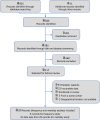Frequency and mortality of sepsis and septic shock in China: a systematic review and meta-analysis
- PMID: 35729526
- PMCID: PMC9210671
- DOI: 10.1186/s12879-022-07543-8
Frequency and mortality of sepsis and septic shock in China: a systematic review and meta-analysis
Abstract
Background: Sepsis, a life-threatening organ dysfunction induced by infection, is a major public health problem. This study aimed to evaluate the frequency and mortality of sepsis, severe sepsis, and septic shock in China.
Methods: We Searched MEDLINE, Embase, PubMed, and Cochrane Library from 1 January 1992 to 1 June 2020 for studies that reported on the frequency and mortality of sepsis, severe sepsis, and septic shock conducted in China. Random effects models were performed to estimate the pooled frequency and mortality of sepsis, severe sepsis, and septic shock.
Results: Our search yielded 846 results, of which 29 studies were included in this review. The pooled frequency of sepsis was estimated at 33.6% (95% CI 25.9% to 41.3%, I2 = 99.2%; p < 0.001), and the pooled mortality of sepsis, severe sepsis and septic shock were 29.0% (95% CI 25.3%-32.8%, I2 = 92.1%; p = 0), 31.1% (95% CI 25.3% to 36.9%, I2 = 85.8%; p < 0.001) and 37.3% (95% CI 28.6%-46.0%, I2 = 93.5%; p < 0.001). There was significant heterogeneity between studies. With a small number of included studies and the changing definition of sepsis, trends in sepsis frequency and mortality were not sufficient for analysis. Epidemiological data on sepsis in the emergency department (ED) are severely lacking, and more research is urgently needed in this area is urgently needed.
Conclusions: Our findings indicated that the frequency and mortality of sepsis and septic shock in China were much higher than North America and Europe countries. Based on our results, an extremely high incidence and mortality of sepsis and septic shock in China's mainland requires more healthcare budget support. Epidemiological data on sepsis and septic shock in ED are severely lacking, and more research is urgently needed in this area. Trial registration This systematic review was conducted according to the statement of the preferred reporting items for systematic review (PROSPERO CRD42021243325) and the meta-analysis protocols (PRISMA-P).
Keywords: China; Frequency; Meta-analysis; Mortality; Sepsis.
© 2022. The Author(s).
Conflict of interest statement
The authors declare that they have no conflict of interest.
Figures





References
-
- Bone RC, Balk RA, Cerra FB, Dellinger RP, Fein AM, Knaus WA, et al. Definitions for sepsis and organ failure and guidelines for the use of innovative therapies in sepsis. The ACCP/SCCM Consensus Conference Committee American College of Chest Physicians/Society of Critical Care Medicine. Chest. 1992;101(6):1644–1655. doi: 10.1378/chest.101.6.1644. - DOI - PubMed
Publication types
MeSH terms
Grants and funding
LinkOut - more resources
Full Text Sources
Medical

